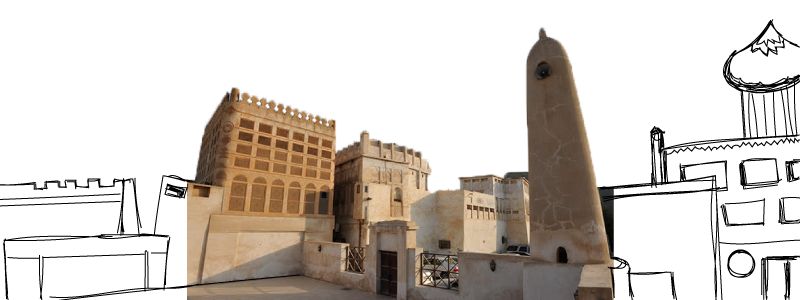I’m sitting next to a wall covered in photos of Umm Kulthoum. From behind her omnipresent sunglasses, she looks down sternly on the crowded teashop, sharing wall space with dozens of other notable personalities from the Middle East. Along the ceiling hang WWI-era rifles, dusty phonographs, and lank flags discolored by years of cigarette smoke. My new friend Omar orders us another round of Karak Chai and resumes his animated explanation of why the pop star Shakira is such a great dancer — he insists it’s because she was born in Bahrain; I learn later she was born in Colombia. While Omar speaks, all sweeping gestures and croaking voice, I take a sip of scalding tea and compose my face, trying not to betray the fact that my heart is lurching wildly, like a drunk trying to skip rope. I take another sip and tell myself it’s just the highly-caffeinated, sugary tea, and not the heart attack my anxiety disorder insists is imminent.
I’m on the island of Muharraq in the Kingdom of Bahrain to explore Pearling, Testimony of an Island Economy, a site known colloquially as the Pearling Trail. Currently in the midst of construction, the serial heritage site will encompass a segment of the seafront, three offshore oyster beds, and 17 buildings connected by a three-and-a-half-kilometer pathway running through a historic neighborhood. The Trail is Bahrain’s second UNESCO World Heritage Site and will offer visitors a vision of the culmination of the 7,000-year Arabian Gulf pearling tradition. This summer, over and over again, I keep returning to walk this path with my notebook and water bottle in tow. “But it isn’t finished yet,” people tell me, worried I’ll be disappointed; but seeing it at this time, in the midst of its birth, when some parts are done and some parts are still old and crumbling, is exactly why I can’t stay away. After a year when my world was swallowed up by cataclysmic anxiety, this is supposed to be the summer that I change, too, and so I keep returning to be near something else that is being transformed.
Omar introduced himself by waggling his fingers from across the tea shop in the “I love you” symbol that he insists is really an “I like you” symbol, pulling up a chair, and launching into a description of what life will be like come the apocalypse. He soon ranges onto other topics. Once he realizes I’ve come to see the Pearling Trail, he smacks his hands together in delight, and I don’t even have the chance to finish my second cup of tea before he pulls me outside and hustles me to the corner, urging me to “see it all.” The last thing I see of him is a hand lifted into the “I like you” symbol disappearing into the crowd.
I began my journey early this morning, taking a boat from the National Museum in Manama across the harbor to Muharraq’s Qal‘at Abū Māhir, a small fort built during the Portuguese occupation from where pearling dhows used to launch. For centuries, the pearls found off Bahrain’s coast were considered the best in the world, their luminous glow attributed to the mix of fresh and salt water that mingles around the island and thought to have given the country its name — Bahrain is the dual form of the Arabic word bahr and means “two seas.” Bahrain’s pearls are mentioned as early as 2000 B.C. in Assyrian texts, but the golden age of pearling was the late 19th century, when pearls were more valuable than diamonds. It is predominantly this time period that the Pearling Trail showcases. With Japan’s introduction of artificially cultivated pearls in the 1930s, Bahrain’s pearling industry began to decline and within a decade was largely abandoned.
From Qal‘at Abū Māhir, I make my way deeper into the city, to Al-Ghūṣ, the Pearling Professional’s House, which represents the style of home that could have belonged to a dhow captain, a nūkhidhah. It is a small but comfortable building constructed from coral stone around a neat gravel courtyard. Inside is a display case that lays out the only equipment a diver would have had against the dangers of the sea — a nose clip, knife, leather finger pads, a weighted rope, and a collection basket. Looking at this paltry collection, I try to imagine the dangers the divers faced. There were the illnesses that came with such a grueling job — skin and eye infections, bronchitis, and burst eardrums were common. There were also jellyfish, poisonous sea snakes, and even sharks to contend with. In ancient times, Muharraq was reputed to have been home to a shark-worshipping cult; I find this notion of taking something so terrifying and making it into an object of devotion incomprehensible.
I am well-versed in daily confrontations with fear, although, unlike the pearl divers of Muharraq, my terrors are entirely self-inflicted. In the last year, the anxiety disorder that has plagued my life since childhood has reached cataclysmic proportions and cannibalized my life: the summer holiday, the art exhibition I was meant to curate, the reading of my work at the museum — all canceled in a fugue of panic. Fed up, I told myself this summer I would recalibrate and somehow find a way to recover. This extended visit in Bahrain is a part of that, a move toward regaining my bearings, but with the constant threat of panic attacks dogging my every step, even coping sometimes seems impossible.
As I leave Al-Ghūṣ, a lone cry pierces the air and prayer call erupts from all directions. Muharraq is dense with mosques, and I feel like I’m moving through a matrix of worship. Long ago, the area was largely Christian, and many of the village names still reflect this history, such as Al Dair, which means “the monastery,” and Qalali, which means “monk’s cloisters.” I move deeper into the heart of the city, looking for Badr Ghulum, the home of a folk medicine doctor who specialized in the treatment of diving maladies, but no matter how closely I follow the map I can’t seem to find it. As I wander in the blazing heat and grow increasingly frustrated, I eventually find myself at Al Jalahma House, a family residence included in the Pearling Trail for its sophisticated architecture. Currently in the midst of restoration, the building is empty except for the flock of pigeons that have taken up residence in the ceiling rafters, filling the air with their pungent, gamey scent.
Too much of what I see about anxiety these days sums it up as a quirky bit of nerves or an endearing streak of gawky shyness. Only those who have suffered inside anxiety’s bleak panopticon know it for what it truly is — all-consuming terror. Anxiety is every alarm system in your body screaming at you to be ready because the very worst thing you can imagine is definitely just around the corner. For some people, anxiety is a remnant of a defense mechanism gone awry. After undergoing too much trauma, the mind decides the safest bet is to see danger everywhere. Eventually, this deluge terraforms the topography of the brain, shaping an image of the world that seems realer than real, and you are left trying to explain to your family and friends why you can no longer do this, go there, eat that, or any number of small but cumulatively shattering losses. And even though on some level you understand that the threats you see are mirages sprung from your past, it rarely makes facing them any easier.
I once had a tarot card reading and the card that was pulled to indicate my lifetime teacher was the Devil. In the archetypal realm of the tarot, the Devil as teacher indicates a need to take back your power and realize that you feel helpless only because you think you are. “Whatever you’re afraid of can’t really hurt you,” the tarot reader said, “but you will believe it can. Does that resonate?” All I could do was laugh.
An important part of coping with an anxiety disorder is learning to distance yourself from the sinister version of the world created by your illness, which exists only in your head, and to engage once again with the authentic world around you. From this vantage point, psychogeography can be a method of healing. French political theorist Ivan Chtcheglov wrote, “The dérive is certainly a technique, almost a therapeutic one.” Surely, if the dérive is capable of subverting the grip of the society of the spectacle, it is qualified to challenge the ossified thought processes of my anxiety-ridden mind. While walking I am forced to slip out of my head, to leave behind the ruminative, circular thoughts that tighten like a noose around my neck, and become part of a larger, more expansive ecosystem. In this vein, I have lately been translating the practice of lectio divina — divine reading — into a theory of divine walking. I am curious to see what can happen when we train ourselves to see the divine in the most mundane of places; so as I explore Al Jalahma I pay attention to the strange slants of sunlight falling overhead and the way they refract off the pale flanks of the building. There are moments when the air itself feels sanctified.
Grudgingly accepting that I won’t find Badr Ghulum today, I continue on and eventually make my way to Al-Alawi House, where I take pictures of the stunning wind tower. I then find the restaurant atop the old date press surrounded by the shops of the souq, where staples like rice, sugar, and coffee were sold. Above them are the apartments where merchants and buyers would haggle over pearls. Nearby is the impressive architecture of the Fakhro House, built by a wealthy timber merchant involved in boat-building. A few streets away, I stop in the teashop to cool off and enjoy a cup of Karak with my new friend. After we say goodbye, I eventually make my way to the Siyadi complex, where the Pearling Trail ends.
The Siyadi complex consists of two large family residences and a mosque, built by a prominent tājir al-lū’lū’ — grand pearl merchant family. The architecture of the mosque, which is the oldest preserved mosque in Muharraq, is strikingly different from what I’ve seen in the area. The stark, conical minaret and austere courtyard give it an ancient air, an impression heightened by the shadows cast by the adjacent house. In contrast to the simplicity of the mosque, the house next door is highly ornamented and is considered one of the most beautiful on the island, a testament to the great wealth created by the pearling trade. I’m not sure if restoration is taking place or if the property is closed for the midday break, but I’m unable to enter. I circle the buildings and feel a sudden, giddy sense of accomplishment at having reached the end of the trail.
Walking back to my car, I let myself take turns at random, glad to be free of the burden of a map. I navigate purely by beauty, drifting toward brightly painted murals and leafy outcroppings, running my hands along rough walls to feel the embedded seashells and gritty layers of texture. I find myself in an alley flanked by high, whitewashed walls; the blue sky a river overhead. An open double-hinged wooden door reveals a large courtyard where a team of workmen is resting in the shade of a palm tree. One of them spots my camera and waves me inside before settling back down to nap. I step through the doors and gasp.
Full of scrubby grass, tall palms, and vibrant blue-shuttered windows, the courtyard is a perfectly formed jewel. I walk around the perimeter, entranced, and notice that my heart, now that I’m not obsessing over its every twitch, is finally calm. Sitting down on a low wall, I think about deep waters and shark gods and venerating that which we fear the most. When it comes to the Devil card, supposedly the representation of my life’s teacher, Jessa Crispin suggests that bowing to the force that has undone us can be a heroic gesture. “You were laid low by a force greater than yourself,” she writes. “So acknowledge it. Kneel to it.” When I first read those lines, something lodged deep in the substratum of my brain; maybe it did a little terraforming of its own, because I’ve started to see things differently now.
In mythology, it is the prerogative of the gods to make worlds and fill them with life, both benign and monstrous. And in a way, I’ve come to see that those of us with anxiety are our very own fire-and-brimstone gods, raising up worlds and inflicting the greatest of terrors upon ourselves. My devastating, all-consuming anxiety is entirely self-generated; I have filled a world with terrors and I quake before them. And if I am that mighty, that powerful, then how can I also be this terrified? My hope is that this new practice, this divine walking, will enhance my ability to see filaments of the divine in the unlikeliest of places, and that when you’ve learned to see the divine in the crumbling roost of a flock of pigeons or the sheer golden light of a noontime sun, then maybe it won’t be so hard to see it within the gnarled pieces of your own psyche.
Sitting there beneath a towering date palm, I let the alchemy of the dérive work its magic within me. It happens like this sometimes: threads of thought, which aren’t even necessarily new thoughts, weave themselves together in distinctly novel ways, revealing startlingly new topographies. In the internalization of the drift, new vistas are reached, and I can see for the first time the mighty intelligence of my body, which is only doing, in its fierce, animal way, the wisest thing it knows. There, in the dappled sunlight, I think of the hard, beautiful reaches of the past; I think of pearls, shark gods, and fear; I think of new ways of living and remembering and learning to breathe in all the hallowed spaces between. •
Illustrations created by Emily Anderson.
Photo of Siyadi complex copyright Saleh Alaradi / BACA
Feature Image by Jakob Owens on Unsplash








